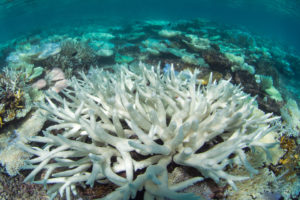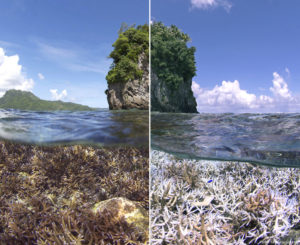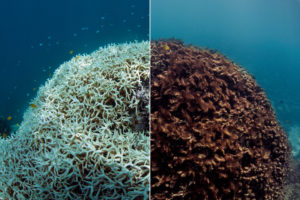Climate Change from a Diver´s Perspective
 In times of devastating hurricanes like Harvey and Irma, destructive bush fires spreading across the north-west of the US and a president of one of the most powerful nations in the world still claiming climate change to be a hoax, it’s more important than ever to raise as much awareness as possible to science-based facts and self reflect on what options every single individual has to support our unique and badly endangered ecosystem. As a diver, no matter wether you’ve just done your first certification or you’re a ‘pro by heart’, you should act as an ambassador to and protector of our oceans.
In times of devastating hurricanes like Harvey and Irma, destructive bush fires spreading across the north-west of the US and a president of one of the most powerful nations in the world still claiming climate change to be a hoax, it’s more important than ever to raise as much awareness as possible to science-based facts and self reflect on what options every single individual has to support our unique and badly endangered ecosystem. As a diver, no matter wether you’ve just done your first certification or you’re a ‘pro by heart’, you should act as an ambassador to and protector of our oceans.
One of the most important facts for divers and non divers to understand, is that this sport does not interfere with nature on a higher level than any other sport practiced outdoors such as hiking, skiing or mountain climbing. Diving might even have a smaller footprint than those mentioned above – from your very first stage of training, a dive instructor should provide you with guidelines and techniques on how to preserve the seascapes and in what manner to interact with the dwellers there, whereas there is no mandatory briefing before people set out on their first hike ever or ski down a slope. Mountain climbing instructors do not necessarily have to provide information on how to protect the stretch of land they’re practicing on. Dive instructors do.
 Ocean deoxygenation and coral bleaching
Ocean deoxygenation and coral bleaching
Ocean deoxygenation describes the loss of oxygen from the ocean. While studies show that during the 20th century oxygen levels were continuously decreasing due to surface warming, there is a prediction of a further loss of 3-6% of oxygen concentrations in the 21st century. Warm water can’t hold as much oxygen as cold water, so when the surfaces of the oceans heat up due to climate change it causes a direct loss of oxygen. But hand in hand with a rise of the surface temperature comes a change in density of the now warmer water. The cold water from below is way thicker than warm water from the surface, which makes it more complicated for the two layers to mix up. In the end this doesn’t only leave us with the heated up surface water, which can’t hold as much oxygen as it used to, it also brings along a malabsorption of the narrowed amount of oxygen from the surface layer.
The process commonly known as coral bleaching is induced through increasing water temperatures. The collaboration between corals and algae is a rather special one. The corals have very high light requirements, which emerge from the symbiosis with the algae, which live in the cells of the coral and also provide them with their rich colors. The metabolic waste produced by the coral serves as fertilizer for the algae and in return they receive part of the vegetational photosynthesis products. A lot of coral subspecies depend on this as main nutrition as plankton alone can’t feed them sufficiently. Certain circumstances, incl. high water temperatures, can cause coral to reject the algae, and therefore loose their color and suffer death by starvation.
Shark and Whale diminution – and the impact on our climate
It’s no secret that the numbers of big marine predators like sharks are constantly decreasing. But recent studies from different marine conservation organisations display a new consequence. With the shrinkage of predatory fishes through fishing and fining, the biomass of smaller fishes and zooplankton expands tremendously, which produces more CO2 in general and decimates a fair amount of the important phytoplankton through nutritional consumption by said fishes. Phytoplankton, as proved in multiple studies, nowadays is responsible for 70% of Earth’s oxygen.
Whales are enhancing the growth of phytoplankton in a completely different way – by feeding at a depth of up to a few hundred meters and defecating at sea level they transport essential sources of iron and other nutrients across layers of water that otherwise wouldn’t mix. The phytoplankton at the surface thrives on this nutritional diet and therefore multiplies and absorb more CO2.
 As divers, we should all try to display exemplary behaviour when interacting with the environment and living organisms above and underneath the surface and engage in our local diving industry to support diving with a minimal damage – e.g. by installing buoys where possible, so boats won’t have to drop the anchor.
As divers, we should all try to display exemplary behaviour when interacting with the environment and living organisms above and underneath the surface and engage in our local diving industry to support diving with a minimal damage – e.g. by installing buoys where possible, so boats won’t have to drop the anchor.
For those who want to take the extra step towards a compensation of carbon dioxide released in regards of their (remote) dive holiday check out
https://www.atmosfair.de/en or for tips on personal cuts in rewards of reduced CO2 emissions https://www.carbontax.org/whats-a-carbon-tax/.
So while North America starts to evaluate the damage Irma has caused on its horrific way across the Caribbean Islands and onto mainland Florida, I hold my breathe and pray for the vast underwater landscapes and its inhabitants, that had to endure this powerful storm without any kind of protection. Hopefully those precious marine sanctuaries are still in a position in which they’re capable of rejuvenating themselves and won’t suffer too much from the damage they had to withstand.
-by Nina Berti Sep 2017
Sources
Keeling at al. 2010
IPCC 5th Assessment Report
https://www.nabu.de/natur-und-landschaft/meere/lebensraum-meer/02888.html
http://www.nationalgeographic.org/activity/save-the-plankton-breathe-freely/
https://www.sharks.org/blogs/science-blog/sharks-in-decline
Photos: The Ocean Agency

